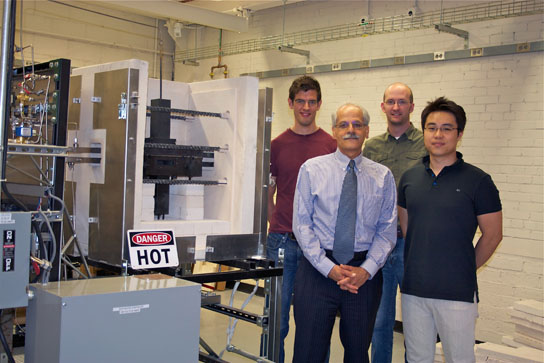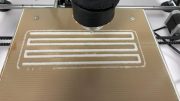
Members of the Ghoneim lab, from left to right, Anton Hunt, Ahmed Ghoniem, Patrick Kirchen and James Hong. CreditPhoto courtesy of the Ghoneim lab
Scientists believe “carbon-capture” technology may significantly reduce greenhouse gas emissions from energy sources such as coal and natural gas. They are evaluating a system that uses a ceramic membrane to separate oxygen from air, efficiently eliminating nitrogen from the combustion process and delivering a pure stream of carbon dioxide that can be stored in natural reservoirs, deep in the Earth’s crust.
It may seem counterintuitive, but one way to reduce carbon dioxide emissions to the atmosphere may be to produce pure carbon dioxide in power plants that burn fossil fuels. In this way, greenhouse gases — once isolated within a plant — could be captured and stored in natural reservoirs, deep in the Earth’s crust.
Such “carbon-capture” technology may significantly reduce greenhouse gas emissions from cheap and plentiful energy sources such as coal and natural gas, and help minimize fossil fuels’ contribution to climate change. But extracting carbon dioxide from the rest of a power plant’s byproducts is now an expensive process requiring huge amounts of energy, special chemicals, and extra hardware.
Now researchers at MIT are evaluating a system that efficiently eliminates nitrogen from the combustion process, delivering a pure stream of carbon dioxide after removing other combustion byproducts such as water and other gases. The centerpiece of the system is a ceramic membrane used to separate oxygen from air. Burning fuels in pure oxygen, as opposed to air — a process known as oxyfuel combustion — can yield a pure stream of carbon dioxide.
The researchers have built a small-scale reactor in their lab to test the membrane technology, and have begun establishing parameters for operating the membranes under the extreme conditions found inside a conventional power plant. The group’s results will appear in the Journal of Membrane Science, and will be presented at the International Symposium on Combustion in August.
Ahmed Ghoniem, the Ronald C. Crane Professor of Engineering at MIT, says ceramic membrane technology may be an inexpensive, energy-saving solution for capturing carbon dioxide.
“What we’re working on is doing this separation in a very efficient way, and hopefully for the least price,” Ghoniem says. “The whole objective behind this technology is to continue to use cheap and available fossil fuels, produce electricity at low price and in a convenient way, but without emitting as much CO2 as we have been.”
Ghoniem’s group is working with other colleagues at MIT, along with membrane manufacturers, to develop this technology and establish guidelines for scaling and implementing it in future power plants. The research is in line with the group’s previous work, in which they demonstrated a new technology called pressurized oxyfuel combustion that they have shown improves conversion efficiency and reduces fuel consumption.
Streaming pure oxygen
The air we breathe is composed mainly of nitrogen (78 percent) and oxygen (21 percent). The typical process to separate oxygen from nitrogen involves a cryogenic unit that cools incoming air to a temperature sufficiently low to liquefy oxygen. While the freezing technique produces a pure stream of oxygen, the process is expensive and bulky, and consumes considerable energy, which may sap a plant’s power output.
Ghoniem says ceramic membranes that supply the oxygen needed for the combustion process may operate much more efficiently, using less energy to produce pure oxygen and ultimately capture carbon dioxide. He envisions the technology’s use both in new power plants and as a retrofit to existing plants to reduce greenhouse gas emissions.
Ceramic membranes are selectively permeable materials through which only oxygen can flow. These membranes, made of metal oxides such as aluminum and titanium, can withstand extremely high temperatures — a big advantage when it comes to operating in the harsh environment of a power plant. Ceramic membranes separate oxygen through a mechanism called ion transport, whereby oxygen ions flow across a membrane, drawn to the side of the membrane with less oxygen.
A two-in-one solution
Ghoniem and his colleagues built a small-scale reactor with ceramic membranes and studied the resulting oxygen flow. They observed that as air passes through a membrane, oxygen accumulates on the opposite side, ultimately slowing the air-separation process. To avert this buildup of oxygen, the group built a combustion system into their model reactor. They found that with this two-in-one system, oxygen passes through the membrane and mixes with the fuel stream on the other side, burning it and generating heat. The fuel burns the oxygen away, making room for more oxygen to flow through. Ghoniem says the system is a “win-win situation,” enabling oxygen separation from air while combustion takes place in the same space.
“It turns out to be a clever way of doing things,” Ghoniem says. “The system is more compact, because at the same place where we do separation, we also burn. So we’re integrating everything, and we’re reducing the complexity, the energy penalty, and the economic penalty of burning in pure oxygen and producing a carbon dioxide stream.”
The group is now gauging the system’s performance at various temperatures, pressures and fuel conditions using their laboratory setup. They have also designed a complex computational model to simulate how the system would work at a larger scale, in a power plant. They’ve found that the flow of oxygen across the membrane depends on the membrane’s temperature: The higher its temperature on the combustion side of the system, the faster oxygen flows across the membrane, and the faster fuel burns. They also found that although the gas temperature may exceed what the material can tolerate, the gas flow acts to protect the membrane.
“We are learning enough about the system that if we want to scale it up and implement it in a power plant, then it’s doable,” Ghoniem says. “These are obviously more complicated power plants, requiring much higher-tech components, because they can much do more than what plants do now. We have to show that the [new] designs are durable, and then convince industry to take these ideas and use them.”
The lab work and the models developed in Ghoniem’s group will enable the design of larger combustion systems for megawatt plants.
Madhava Syamlal, focus area leader for computational and basic sciences at the National Energy Technology Laboratory, says simulations such as Ghoniem’s will help push next-generation technologies such as oxygen-separating membranes into power plants. “We have seen that in other areas, like aircraft, simulations really improve how the product is developed,” Syamlal says. “You can use simulations and even skip some of the intermediate testing and go directly to designing and building a machine. In the energy industry, these are the pieces we need to increase the scale quite rapidly.”
Reference: “Numerical simulation of ion transport membrane reactors: Oxygen permeation and transport and fuel conversion” by Jongsup Hong, Patrick Kirchen and Ahmed F. Ghoniem, 16 March 2012, Journal of Membrane Science.
DOI: 10.1016/j.memsci.2012.03.018
Ghoniem’s group includes research scientist Patrick Kirchen and graduate students James Hong and Anton Hunt, in collaboration with faculty at King Fahed University of Petroleum and Minerals (KFUPM) in Saudi Arabia. The research was funded by KFUPM and King Abdullah University of Science and Technology.









This post is very much informative and at the same time has the same goals as ours. At Ecosol Global we offer R.E.D Teslagram to help people lessen harmful emissions. Thanks.
Lessen Harmful Emissions
Question: We just found out thet there are massive unknown biomes of bacteria living inside our planet under the soil. We don’t even know the purpose of these bacteria and the role they play in the eco system yet they are twice the total mass of the ocean or some 500 million cubic pounds in mass and you’re going to pump them up with carbon-dioxide, potentially mutating, exciting or killing all of these in contact with your pumped carbon gas pimples under the surface of the ground. Is this safe, wise, or tested? Probably no on all three accounts. What are we doing messing around with carbon pollution? ITs still pollution no matter how you spin it, store it, etc. Let’s just not even mess with this technology, the dirty fuel power plants all need to be shut down and disposed of. We don’t have much time people to be messing around, climate change is already happening an accelerating faster than predicted. We DON’T HAVE TIME to mess with carbon technology and cleaning it up. We have been trying to clean it up for decades in various capacities and its still gotten us nowhere but the sad state of environment we are in now. This is a waste of time. It is more sure, safer in the long run to get rid of coal and gas plants and move to all renewables with any number of excellent storage technologies such as pumped water, molten salt reservoir, or improved battery technology storage (flow-cell) which is becoming cheaper than operating more power plants at night. Especially when most nightly plants would be non-renewable in nature. That cost is a long term cost we are trying to avoid here…. We can’t even prove the stored carbon dioxide won’t leak into the environment and cause new troubles of an unknown nature. Anything we’ve ever pumped in or out of the ground has leaked in a spectacular and dangerous way at one point or another. Why are we even messing around with our future like this? Time to grow up, hunker down, and pay for the changes needed to continue to have life on a livable planet. Time to pay the piper folks. Small modifications to existing fossil fuel plants does not cut it and does not take us out of the danger zone. We still burn fuel and carbon with dirty vehicles to bring the coal to the coal plants even if all the burned coal gases could be sequestered down below safely and indefinitely. But we know that just isn’t really likely to work out in the end. Such schemes never come without exceptional failures and unknown numbers of future unknown problems from the longer-term failures we didn’t see coming. Best not to mess around anymore. We can’t afford any new environmental catastrophes and failures to completely protect the environment. It really is clean energy now or forget about future life on this planet very soon. It really is that dire now. Put your money where you mouths are and don’t’ buy another ICE-powered vehicle. Deploy solar on your roof tops or back yards. Its not any longer an option. Things are that deadly serious with us at the tipping point right now. We have but a few short years to fully act before the consequences of not acting are too irreversible in our life time and too dire to cope with.